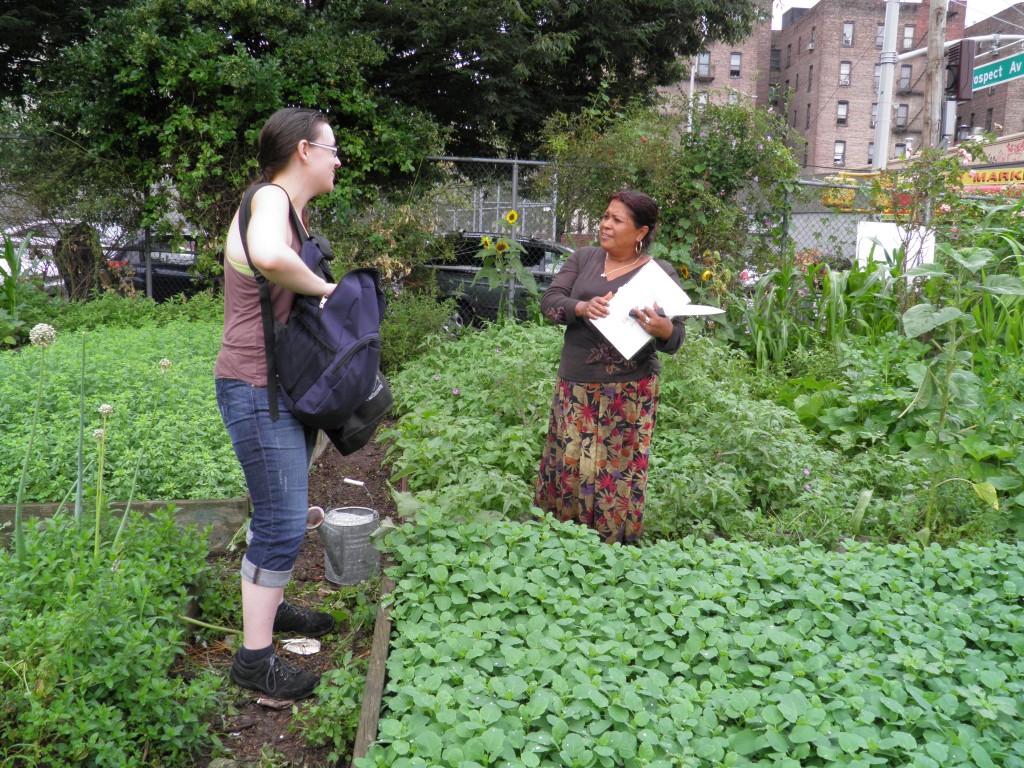And on their way to gardens. We need to order more – please consider a small contribution. Each scale costs only $16, and goes a long way toward preserving community green space.
Garden of Youth, one of the La Familia Verde gardens [Bronx]
This past month has been quite a whirlwind of successes and challenges. We were out in 100+ degree weather and in pouring rain. We took scales and harvest logs on trains, buses, and on foot. We encountered folks who were skeptical of our work, as well as many inspiring and astonishing gardeners who offered us everything from freshly reaped sugar cane (post on this to come) to honey.
Across 4 of the 5 boroughs (we WILL get one from Staten Island!), nearly 300 community gardeners are beginning to track their harvests.
- Garden of Youth receives a scale
Over the next 6-8 weeks, we’ll step up our mapping, and we need your help! Getting the square footage of areas under production is no small task. If you’re interested in helping out just a few hours this month or next, please email volunteer at farmingconcrete dot com. We welcome all levels of experience!


I’m a gardener in an NYRP garden: forms have been delivered and I have to say I’m taken aback and resistant to the measurements. First, I don’t feel like it jibs with the way I harvest. I head out in the morning to water and take a tomato if there’s one getting ripe. I go snip some basil if I need it. I can’t wrap my head around unlocking the shed and logging that information every time!
More to the point though, I’m really resistant to trying to quantify the value of open space, community, horticulture like this. We give away herbs. We have kids groaning because their mom sent them to ask for some green tomatoes, which they hate, but mom said. We’re constantly eating: cherry tomatoes, raspberries, figs so so so soon. If the pounds don’t add up is the garden still useful? Are we all better off for having green sanctuaries? For being able to show kids how squash grows even if we aren’t growing enough to feed the city?
Thank you for your concerns – we very much understand what you are saying, and understand completely the resistance to gathering numbers in a place where so much is invaluable. To us, all aspects of gardens are valuable, and we are by no means doing this because we intend for community gardens to feed the city. We are doing this because (to use your words) we believe being able to show kids (and adults) how squash grows is enormously important for community health and for the sustainability of our food system. We’d like to help folks do this more, so here are our other reasons for doing this project:
– No real literature exists to help gardens, schools, emergency food providers, etc. know how to estimate yield of a small, polyculture raised bed in order to apply for a grant, plan a Garden to Cafe program, or plan a garden for a food pantry. Yields are different (maybe more, maybe less, we’ll see!) in a garden than on a commercial monocrop farm due to intercropping, succession planting, varying skill levels, and many more variables, and we hope to get an average of these in our study.
– The city needs numbers when looking at gardens as a land use and deciding how to or whether or not to protect them. This is not to say that food is the one and only important thing, it absolutely is not, it is *just one thing* that we can count and that we know the city will pay attention to. We’re a small group of volunteers and not an academic institution, so we don’t have the capacity to take on quantifying ecological and social benefits. I urge you to read our post entitled Tomatoes or Dollars for more on this.
To answer your question about weighing every little thing, well, it’s up to you. Not every gardener needs to participate because every gardener has their own way of doing things, and we very much respect that. This is why we work bed by bed instead of garden by garden, so that individual gardeners who chose to participate can “weigh out” when they leave. Communal plots are much harder to keep track of for obvious reasons. Ideally, the gardeners who commit will weigh everything that comes off of certain plants, so if the raspberries are communal like they are in my garden, and only get picked here and there, don’t worry about tracking them, but if a head of lettuce gets picked all at once, or it’s just one gardener who harvests and eats the peppers from her/his own plot, that gets marked down. We’re not counting herbs because they only get picked in tiny amounts, and we’re not counting fruit trees because that would be impossible, unless a few individuals decide to take that on.
I hope this answers some of your questions. Feel free to call me if any more come up, and I’m happy to come to your garden to explain in further detail.
Happy gardening 🙂
Best,
Mara
Project Director
908.787.2711
Please keep us informed of your progress in tracking gardens produce success.
And let me know when you will be coming to our youth Gardens.
Thank you
Wayne
Temple of Davie community Garden
Will do. We’ll come soon to do some mapping. Thanks Wayne!